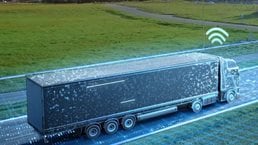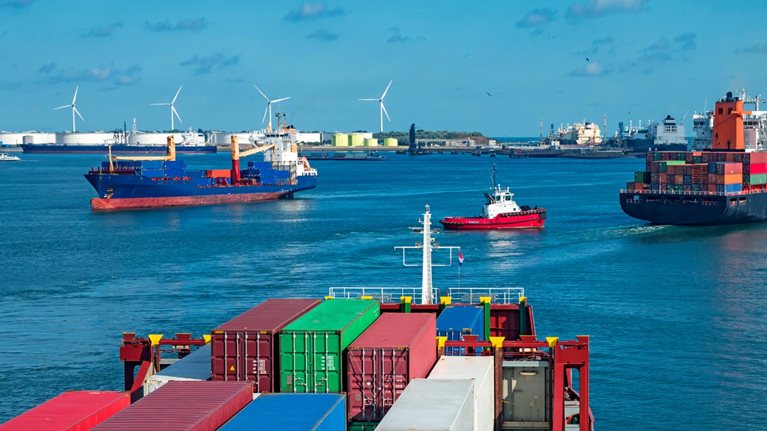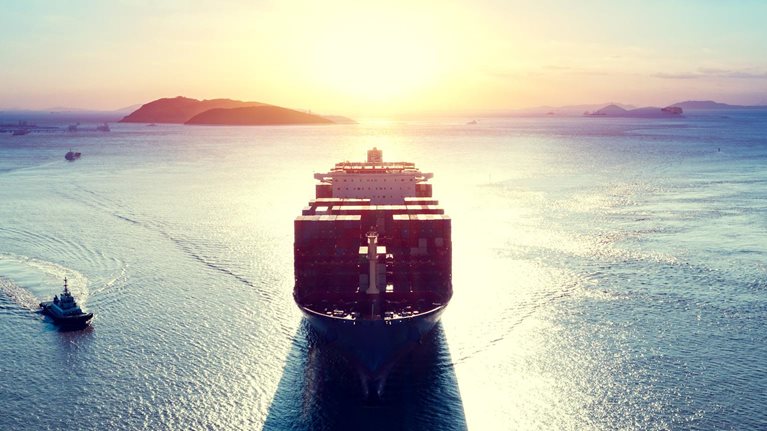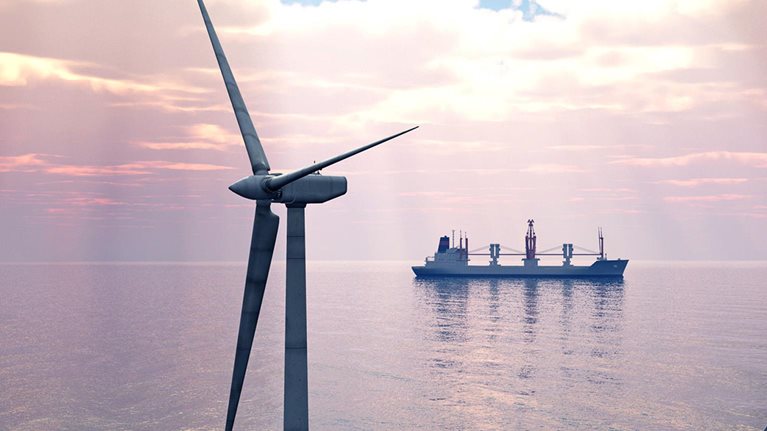ZeroNorth uses data to help shipping companies become more efficient and, by extension, greener. Its interactive platform provides simulations, predictions, analysis, and data-driven insights that can aid shipping companies in their quest to traverse oceans while consuming less fuel. Founded in June 2020, the Copenhagen-based start-up now has about 270 employees in six locations around the globe. ZeroNorth says it helped prevent more than 440,000 tons of CO2 from being emitted by its customers’ ships last year.
“It started with six people and a little bit of code,” says Pelle Sommansson, ZeroNorth’s chief operating officer. “Now we support more than 150 customers and have more than 4,000 vessels on our platform. What makes us unique is our combination of data, technology, and shipping expertise, which lets us create a powerful platform that’s intuitive to use for shipping operations.”
In this installment of Logistics Disruptors, Sommansson—who was previously chief data and analytics officer for IKEA—speaks with McKinsey partner Matt Stone about applying analytics to ocean voyages, listening to insights from captains and crews, and attempting to transform an industry that is sometimes resistant to change.
The following is an edited transcript of their conversation.
McKinsey: ZeroNorth says it wants to “make global trade green.” What exactly does ZeroNorth do that can help get us to that outcome?
Pelle Sommansson: Decarbonization is at the top of everyone’s agenda in the shipping industry. At ZeroNorth, we look for inefficiencies that create waste and for substandard decisions that lead to underperformance. This lets us help shipping companies reduce fuel consumption, which leads to lower emissions, which leads to greener trade.
But this is not just about data analysis. The way to make global trade green is to make our insights concrete and actionable. The key is to drive down emissions while also creating commercial opportunities, benefiting both profits and the planet.
The way to make global trade green is to make our insights concrete and actionable.
McKinsey: What are the specific product offerings that differentiate ZeroNorth?
Pelle Sommansson: ZeroNorth started almost three years ago with one product that focused on speed optimization for ships. We quickly realized that wasn’t enough, so we developed a full weather-routing service to help plan ship routes around weather forecasts. After we had that out in the market and had good results with it, we realized those two products still weren’t enough. So, in the past 12 months we’ve added a portfolio of new services.
We now have an AI-enabled fuel model that’s basically a digital twin of the vessel. It’s able to predict with high accuracy the fuel consumption of the vessel at any given speed, at any given RPM, with any given draft, in any weather, at any point around the world. We also have a product that measures the efficiency of various vessel components—such as the hull, the propeller, the boiler, and the auxiliary engine—to more concretely identify actions that can be taken to improve the vessel’s performance. Then we have our voyage optimization solution, which helps gauge how best to get from point A to point B while keeping the ship’s crew safe, maximizing the financial outcome, and minimizing emissions.
At a basic level, vessels move cargo from port to port by burning fuel—which, in shipping, is also called the “bunker.” That’s essentially the business. Companies need to know, what is the quality of the bunker that we’re burning? What is the cost? Where are we getting it from? How much are we using? So we also have a suite devoted to bunkering processes—from bunker planning to bunker procurement and bunker insights.

Logistics Disruptors
We connect all these services into a single analytics platform to get insights from across shipping operations. This provides a full, true picture of a company’s efficiency and enhances decision making throughout the business.
McKinsey: What has been the customer response to this platform play, in which you have many different services built on top of one platform? How do you maintain your competitive edge?
Pelle Sommansson: If you look at our strategy, we took the book on product management and threw it out the window. Because in classical product management, you focus on one service, do it really well, and then you expand. But we quickly understood that to create efficiency, we needed to look at the auxiliary services surrounding each service. So we were forced into this platform play—attempting to become best-in-class in both the individual bubbles and across them.
The benefit of having one platform is that the services are not in isolation. Once we tie data flows and insights together, we see a network effect where the services all feed into each other. When you have a good fuel model, you’re better at predicting the consumption of a voyage. When you have good voyage routing, you can better understand the condition of waters that the vessel has been in.
In the past, companies typically used a plethora of different applications. The platform model removes complexity to deliver a single source of truth to our customers on a fleet’s consumption, conditions, positions, availability, and weather.
McKinsey: Fairly or unfairly, the shipping industry is sometimes said to be quite conservative in its adoption of digital and analytical tools. What has been your impression—especially as someone relatively new to the industry—in terms of how open and welcoming it’s been to these kinds of solutions? Has there been resistance?
Pelle Sommansson: I think the industry is behind in understanding the need to apply data and technology, both in service of commercial goals and in service of decarbonization efforts. But a lot of the problem is in the what and the how.
Companies have a finite set of assets. Even the biggest players have 600 or 700 vessels, which is quite a small number of individual data points. We can’t really do A/B tests to explore decisions—I can’t send a vessel on two different voyages at the same time, in the same weather conditions, with the same market rates. And at the end of the day, we’re talking about million-dollar decisions, with seafarers’ lives at risk.
At the end of the day, we’re talking about million-dollar decisions, with seafarers’ lives at risk.
There’s a conservatism that relates to keeping the performance of the business up and keeping people safe at sea. I understand the dilemma that many of our customers have. They can’t just try any tool. They need to build trust in it and see that it’s working. They need to understand that our routing is good, that we won’t put their vessels or seafarers at risk, and that they’ll actually get the commercial outcomes that they expect. We work closely with our customers on this journey, and I feel that they’re listening.
McKinsey: Do you get feedback from seafarers who are implementing changes on the water? What do you hear from them?
Pelle Sommansson: We won’t have any impact if the captain and crew don’t make a change on the vessel. It’s on the ship, out on the water, every day and night, that efficiencies actually get created. So we need solutions that are aimed at the crews and captains on the vessels, as well as the team that sits ashore, looking into the performance of the fleet.
The captains live this every day, so they have insights. They’ll ask if they should go around an island using a different route. They’ll ask if there’s data showing that the condition of the hull has changed in a way that’s making the vessel consume more fuel than we’d expected. And we sometimes get pushback that’s based on their experience. But we work hard to build trust and let them see that we have a different level of granularity in our data, that we can react to weather changes, that our fuel model is really accurate, and that we can actually create better routes across the sea.
McKinsey: What inspired you to go into shipping?
Pelle Sommansson: What drew me in was a realization of the complexity of shipping. Of course, I’d read news about delays in supply chains and vessels lying idle off Long Beach [in California]. But through meetings with people in the shipping industry, I started realizing that we are at a pivotal point for a critical component of society.
Shipping has to transform. It has to transform now, and it doesn’t have the tools to do it. I was superintrigued by that challenge. It’s hard to find another industry that is as ripe for disruption as shipping and where technology can have such a large impact. It felt like a unique opportunity in history that I had to jump on.
And then I found this company that is at a unique intersection—of having the clout of understanding how shipping works, coming from our deep maritime heritage, merged with good technology and practices around data analytics, AI, and user experience.
McKinsey: If you had a magic wand and you could suddenly change one thing that would make it easier to decarbonize shipping, what would be the thing that you’d change?
Pelle Sommansson: If I had a magic wand, the obvious thing to do would be to remove weather—it creates so many inefficiencies in shipping! But apart from that, what I really wish is that we could align stakeholders’ business models with the common goal of creating more efficient shipping. Stakeholders often can’t agree on how to share data, or how to work toward decarbonization together. I would like us to harmonize.


